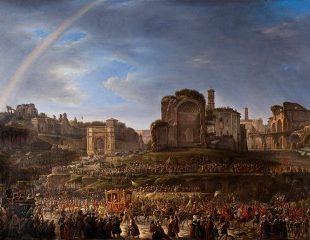
The Carriage Pavilion
Carriage Pavilion, Vatican Museums
On the 34th anniversary of the election of Pope Wojtyla to the Papacy, the Vatican Museums today present, on Tuesday 16th October, the newly-arranged Carriage Pavilion. Enlarged, improved, with a revised order of exhibition and new didactic apparatus, the Pavilion, enriched by new and important acquisitions, has displayed since 1967 the history of papal mobility by means of an original collection of saddles, sedan chairs, carriages and automobiles.
Established in 1967 at the behest of Pope Paul VI, the Carriage Pavilion is an integral part of the Department of Historical Collections of the Vatican, which brings together the Portraits of Pontiffs from 1500 to the present, all the Papal Ceremonial Apparatus, Costumes of the lay Court, and the Arms and Uniforms of the Pontifical Armed Corps.
The nucleus of the collection is constituted by the magnificent Grand Gala Berlin, which Pope Leo XII had built in Rome in 1826; its decorations were further enriched by Pope Gregory XVI in 1841. Also noteworthy are the nine ceremonial berlins which belonged to Pontiffs or Princes of the Holy Roman Church, such as Cardinal Luciano Luigi Bonaparte, who received the carriage as a gift from his cousin Napoleon III, Emperor of France.
Aside from the aforementioned "protocol" carriages, two historical travelling berlin carriages are displayed: one used by Pope Pius IX in his re-entry from exile after the revolts of the Roman Republic, and ther other for the last trip of a "Pope King" in the papal territories of Romagna. In addition, two small berlins for use within the Vatican Gardens and a landau with four seats are also on display. All these carriages, including the sedan chairs, the saddlery and the harnesses for the horses, constitute a rare historical testimony to papal mobility, which came to an abrupt halt with the capture of Rome on 20 September 1870 and its annexation to the Kingdom of Italy.
From 1870 to 1929, the year in which the Lateran Pacts were signed, the Pontiffs never left the Vatican, even interrupting the traditional solemn cavalcade for "taking possession" of the Basilica of Saint John in Lateran. In 1909 the Archbishop of New York offered an Itala 20/30 as a gift to Saint Pius X, which the Pontiff refused, as he preferred to continue his strolls in the Vatican Gardens in a comfortable and less noisy carriage.
The entry of the first automobile in the Vatican occurred, therefore, shortly after the beginning of the pontificate of Pius XI, when the association of Catholic Women of the Archdiocese of Milan donated to the Pope a Bianchi Type 15. But given that the question of the sovereignty of the Vatican had not yet been resolved, a Diplomatic Corps registration plate (CD 404) was affixed to this vehicle.
Immediately afterwards, the Italian automobile manufacturer Bianchi donated a Bianchi Type 20 to Pope Pius XI, thus being the first to obtain the coveted title of "Papal Supplier". With the signing of the Lateran Pacts, the principal international automobile manufacturers therefore competed to present their best vehicles as gifts to the Pope. And so on 21 April 1929 the Fiat 525 Marrived; followed by the Isotta Fraschini 8 on 1 May, and the Graham Paige 837 on 22 December. On 9 June, the Vatican automobile was joined by the Citroën Lictoria Sex, specially designed for the Pope and constructed according to the standards of a pontifical carriage. Finally, on 14 November 1930, the first Mercedes arrived, a long wheelbase 460 Nürburg limousine, designed by Ferdinand Porsche.
From 1931, therefore, the papal carriages were superseded by automobiles and the Automobile Register was instituted. The SCV (Stato della Città del Vaticano) registration plates had red letters on a white background for the Holy Father and other high dignitaries of the Roman Curia, whereas the others had black letters on a white background.
In line with the times, immediately after the 1976 Jubilee there appeared the first "Popemobile", or rather the white off-road vehicle used by the Pontiff for brief trips and for being seen by spectators.



